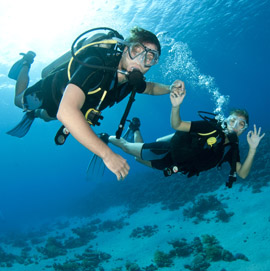Scuba Support: Mastering the Buddy System
Posted: Jan 15 in Dive Blog tagged Diving Safety by Jan
From divers plumbing the ocean’s depths to preschoolers on a field trip, there’s a reason the buddy system is so widely used: it works. Though it is possible to dive on your own, diving with a buddy is both safer and more practical. Your buddy is there to help you put on and check your dive equipment before you go underwater, your buddy is there to help you out of a bind if you need assistance and your buddy is there to share the fun of the diving experience with you.
Still, it won’t do much good to simply strap on your dive gear and jump in together—both of you will need to be on the same page when it comes to communication and your dive plan.
To use the buddy system to your full advantage you’ll need to learn how to:
Communicate With Your Buddy
Because your dive equipment and the water around you will make vocal communication impossible, you and your buddy will need another way to relay information. Unless you have some form of electronic communication this means using your hands or a dive slate, both of which will require visual contact with your buddy. To get your buddy’s attention, tap him or her on the shoulder or rap on your own tank with your dive knife.
Writing on a dive slate takes too long to be practical for simple messages, so hand gestures will make up the majority of your underwater communications. Be sure to review and agree upon hand gestures you will be using to avoid a misunderstanding underwater.
Though you can use similar hand gestures above water, you should be close enough to your buddy to be able to speak normally. Still, if you get separated from your buddy or are in need of assistance, a whistle can be a valuable emergency signal, so be sure both of you are carrying one.
Plan With Your Buddy
You and your buddy should agree on every aspect of your dive before embarking. This includes:
- Dive objectives
- Entry and exit points
- Course
- Time and depth limits
- Returning air pressure
- Emergency procedures
Techniques for staying together and reuniting if separated
You should also perform a thorough pre-dive check of your partner’s dive equipment. Before you take the plunge, take a look at your buddy’s:
- BCD. Is the tank firmly in the band? Is it adjusted and operating correctly?
- Weights. Is your buddy weighted properly? Is the quick release system clear? Does the weight belt have a right hand release?
- Releases. Are you familiar with how your buddy’s releases function? Are they secure?
- Air. Do you both have enough air for the dive? Are your valves open? Are your regulators and alternate air sources working?
After checking these essentials, do a final check for dive equipment that may be missing, dangling or out of place.
Once you and your buddy have planned out your communication and the details of your dive, all that’s left is to keep each other safe underwater. Do your best to stay within a few feet of each other, which will be much easier if you agree on which one of you will lead. You should also agree on a plan to reunite and resume the dive should you get separated.
Remember: the buddy system only works when both of you use it. Stick with the agreed-upon plan, watch each other’s backs and enjoy the shared thrill of underwater exploration.
